THE MAIN EVENT
The morning sun lifts the dew from the
grass as the 60-ton crane is brought into position early on Wednesday.

Griffin Brothers Crane Service pulling in to site, early morning 11/04/2009
Photo:
Mark Lindquist

Setting up the crane
Photo: John McFadden
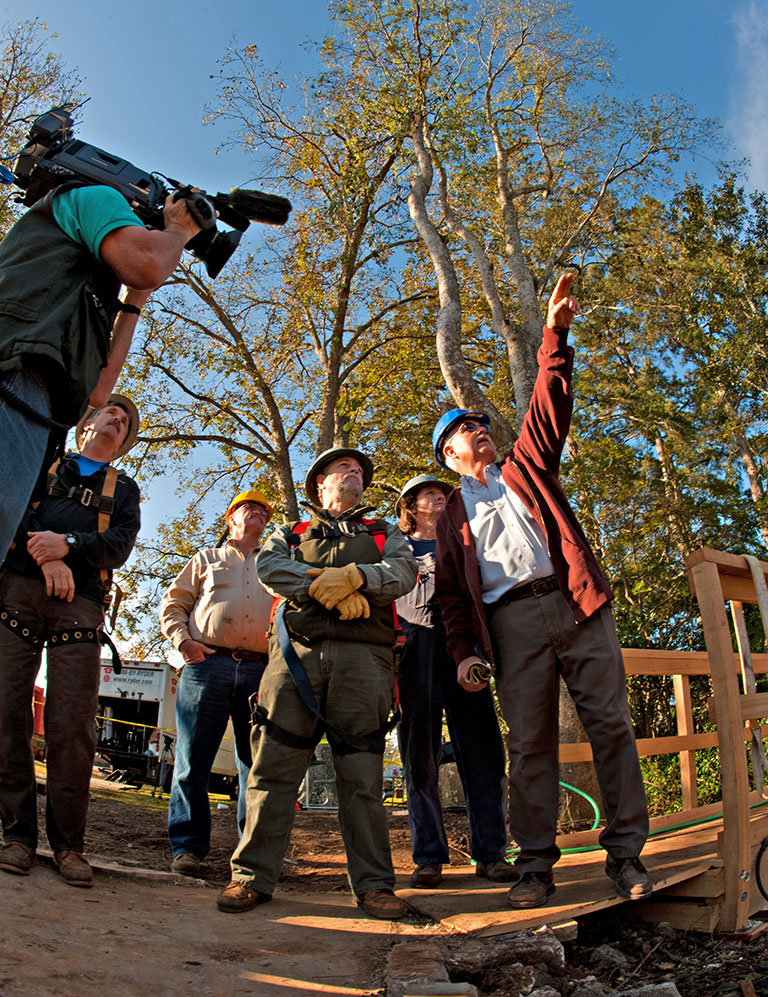
Crane operator Doug Griffin (right)
discusses best rigging scheme during safety meeting
Photo: John McFadden
The tree
is attached to its enormous hook with soft loops that will not damage the wood
when the strain is taken.
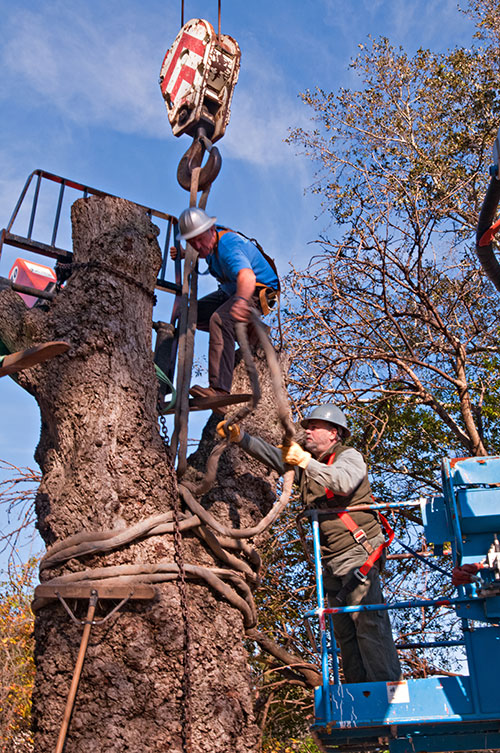
Gary Stevens (left) and Mark Lindquist, rigging the Blakely Burl Tree for
hoisting
Photo: John McFadden
As he has done for every stage of the process, Mark
has Greg filming him while he explains what is happening, why work proceeds the
way it does, and what to expect next. Stanley and I are watching and he wryly
comments to me, “You know, Mark is one of the nicest guys I've met, but when you
work with him he's gonna let you know he's in charge. That's the only way he can
get what he does done!”
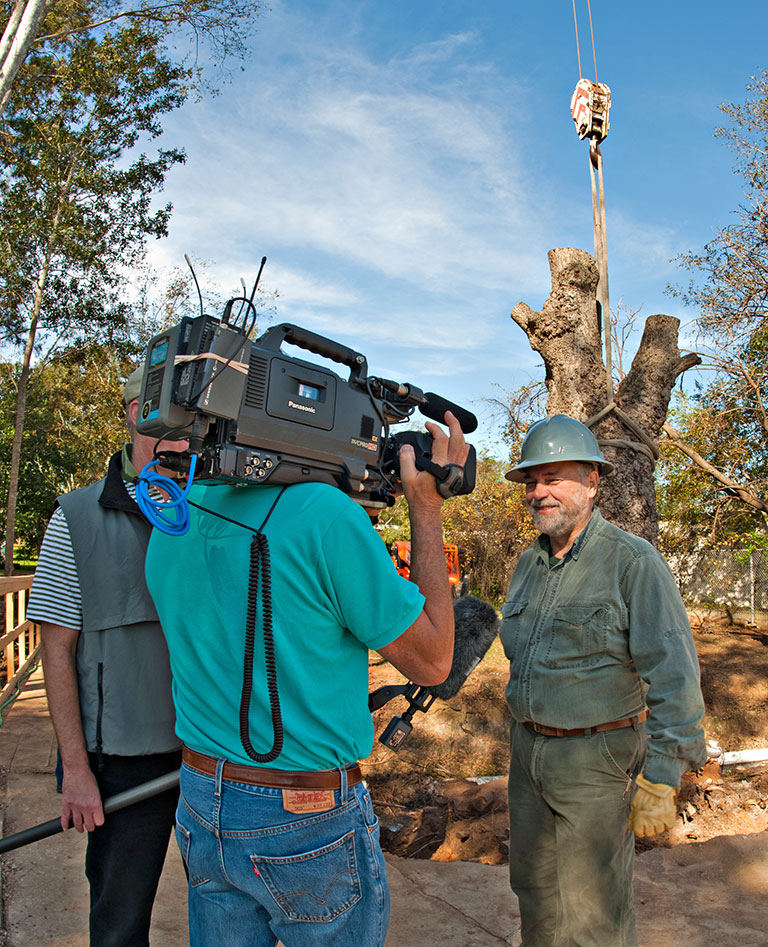
Mark Lindquist (right) being filmed by Greg Andracke (center) and Ken Browne
Photo: John McFadden
Heather delivers welcome morning coffee and sweet rolls, and while we tuck in
Greg Baxley walks up, holding a large bag in his hands. “You wanna see some
arrowheads?” he says. He opens the bag and lays out a wonderful selection on the
bench, spreading his hands over the delicately shaped flints. “Y’all can take
what you want,” he offers. The crew gathers around and soon we have each chosen
our own special souvenir of Blakely. Mr. Baxley looks very pleased. It’s a very
generous gesture and confirms my impression of the kindness of people here.
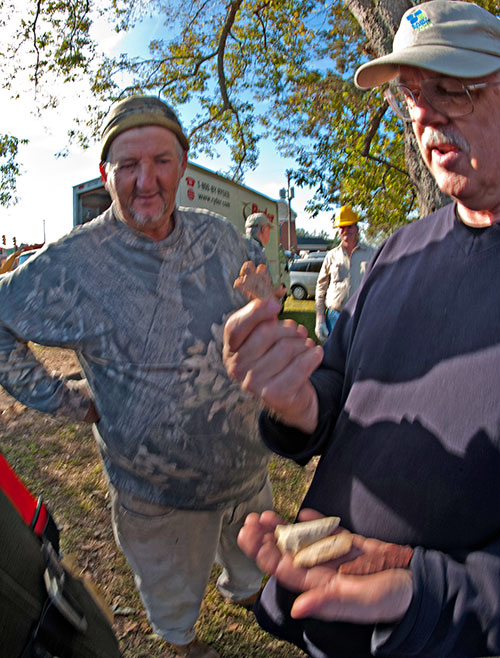
Terry Martin (right) accepting gift of arrowheads from Greg Baxley.
Photo: John McFadden
While we are drinking our coffee, people start speculating about how heavy the
tree is. “It’s gotta be 20,000 lbs,” says one. “No way!” says another. “I’d say
no more than 12,000.” Because the crane can weigh its load, somebody suggests we
run a competition to see who can guess closest to the weight.
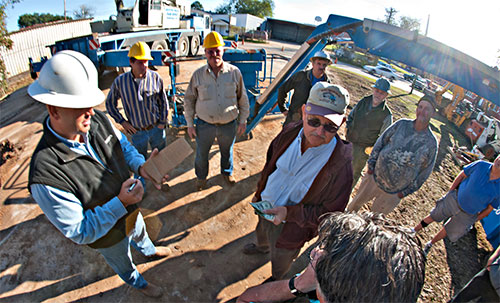
Jim Carver keeps track of guesses, Doug Griffin collects dollars. (The
whole thing was rigged...) Photo:
John McFadden
With the trunk securely attached to the crane, Mark and Gary watch carefully as
the tree is jiggled by the crane. The whole root ball and attached earth
moves. “Gary was right, there’s no taproot!” Mark laughs. Gentle lift is applied
by the crane and Gary swings into action with his 5-foot, carbide-toothed
chainsaw, cutting through grit, wood and soil.

Gary Stevens (right) begins cutting roots as tree is freed from ground.
Photo:
Mark Lindquist
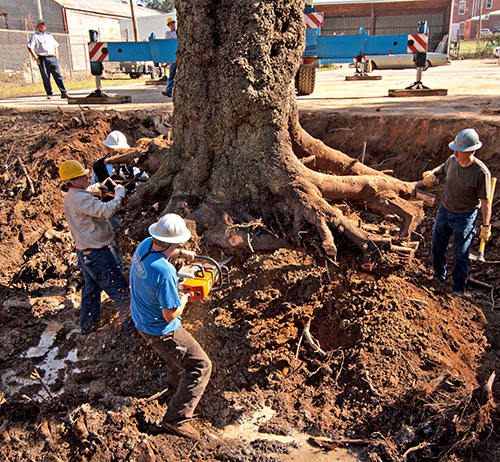
Gary Stevens (right) finishes cutting
roots as tree is freed from ground.
Photo:
Mark Lindquist

Crane begins pulling tree out of
ground. Photo:
Mark Lindquist
As daylight gradually appears
between the root ball and the bed of the Big Ditch, it becomes clear that Gary
is right and there is no taproot. “Boy, that’s a relief!” Mark says. “I was
sweating on that.”
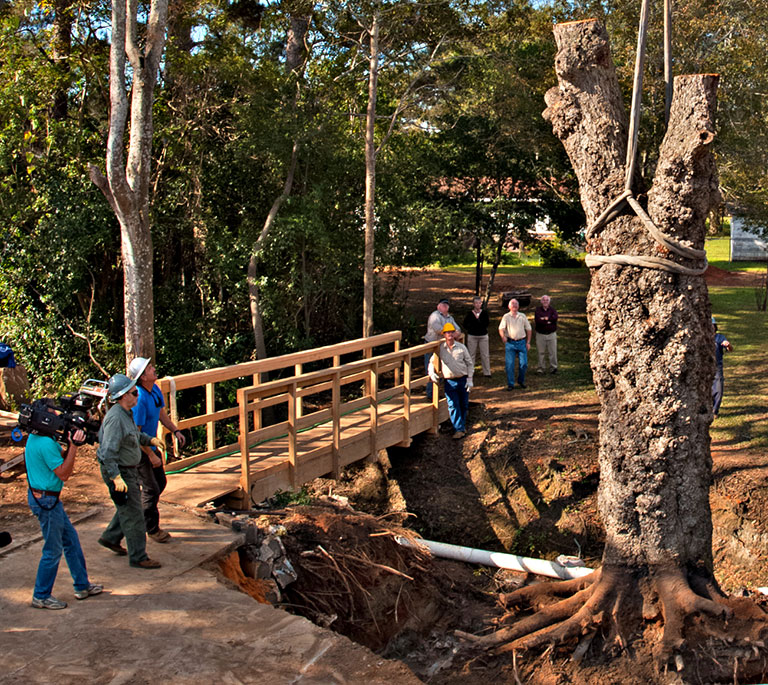
A tense moment as Mark Lindquist and Gary Stevens watch the tree being pulled
out of the ground. A critical time, fraught with danger.
Photo: John McFadden
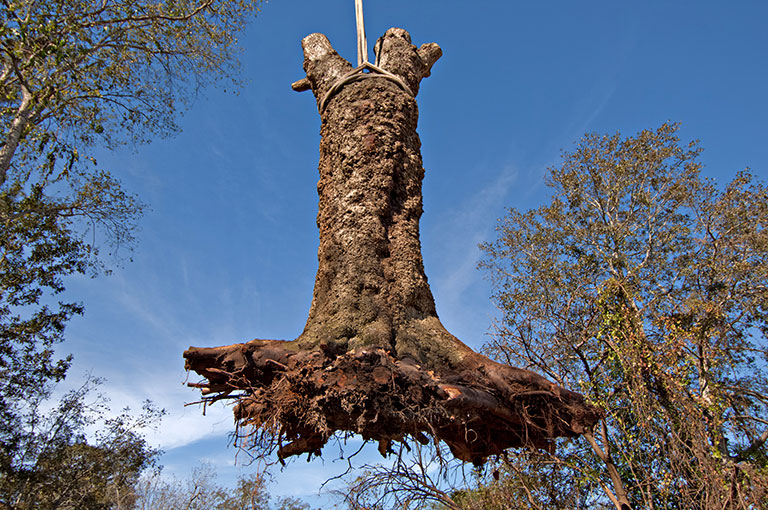
The tree is free from the ground and soars into the sky.
Photo:
Mark Lindquist
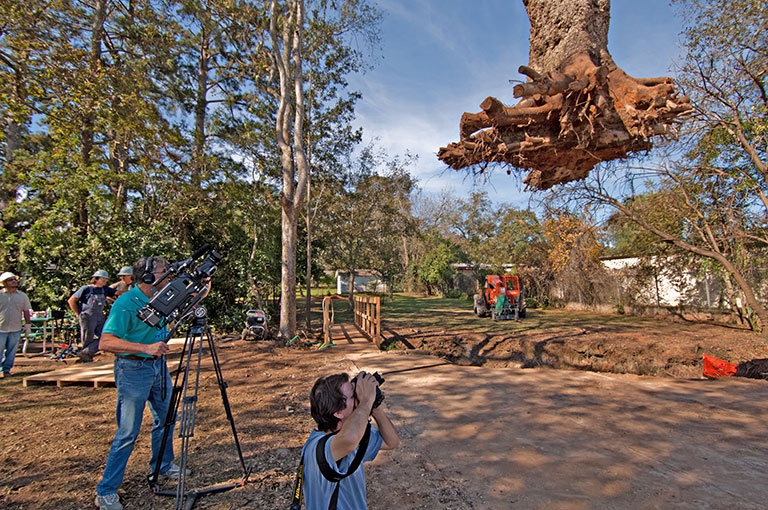
Greg Andracke (left) and John McFadden (right) documenting the action.
Photo:
Mark Lindquist
Everyone immediately wants to know how much it weighs, so work is suspended
while the operator climbs into the crane to check.
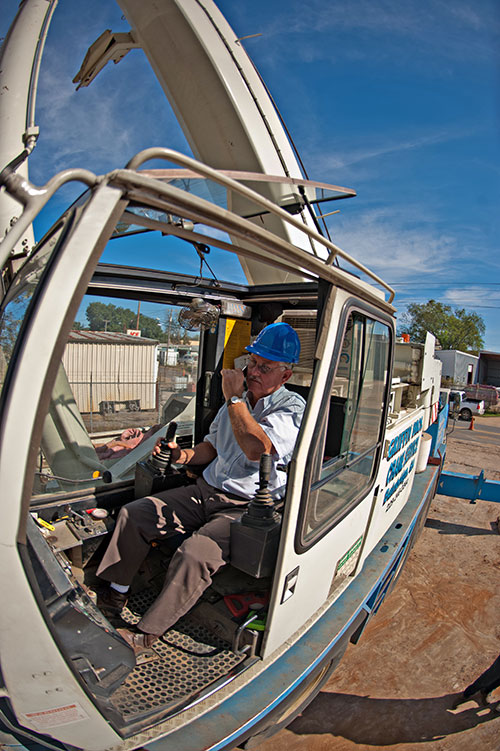
Doug Griffen checks weight on the Blakely Burl Tree.
Photo: John McFadden
It comes in at 19,000 lbs.
Congratulations are offered to the winner, then somebody points out that we were
estimating the weight of the tree, not the tree and the dirt! It’s true, there
is still a huge amount of dirt imbedded within the root system and while it is
still suspended over the Ditch, the team sets to with hand tools to clear as
much of it as possible. Eventually we find that with the bulk of the dirt
removed, the trunk weighs 16,000 lbs. The debate over who really won continues.
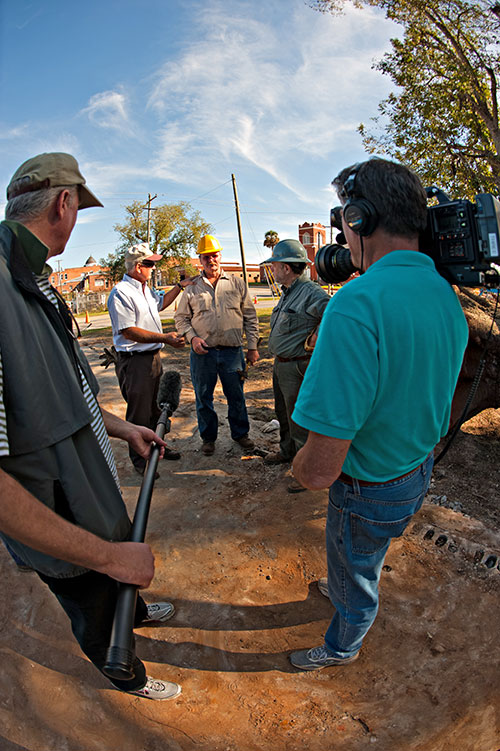
Doug Griffen awards Tommy the cash - being the winner guessing the right
weight.
Photo: John McFadden
There is a beautiful moment as the trunk is raised from the ditch, slowly
spinning in the gentle light. Everyone pauses to watch it rise and swing gently
across the slab.
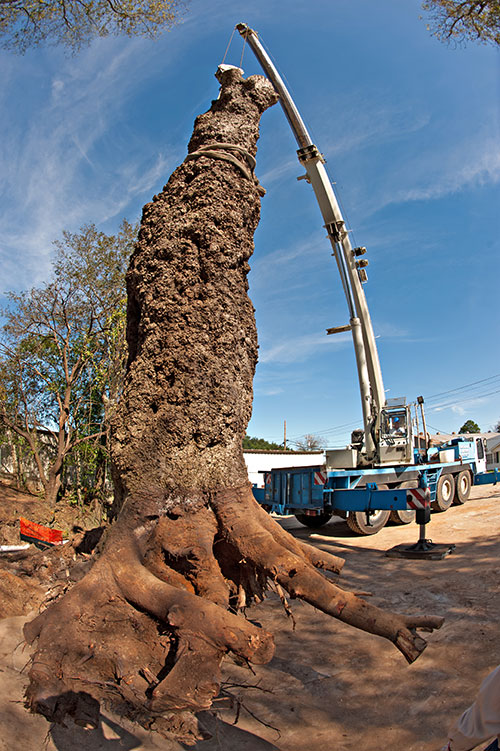
The Blakely Burl Tree, resting above ditch, out of the ground.
Photo: John McFadden

The tree is re-rigged, preparing for the horizontal move, lying the tree
down.
Photo:
Mark Lindquist
We stand back while the tree is gently laid down on its side
and there is such a sense of reverence about the slow movement that I can’t help
feeling it is being laid to rest.
Mark and Gary go into one of their huddles.
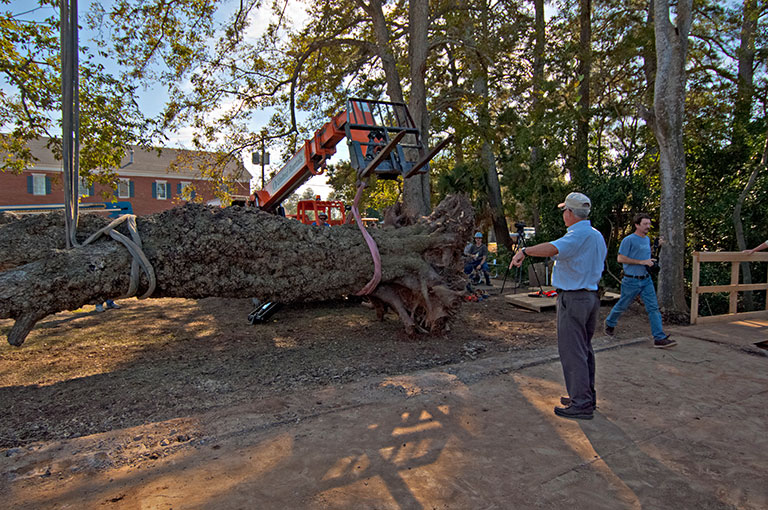
Doug Griffen directing movement of tree, carefully bringing it horizontal.
Photo:
Mark Lindquist
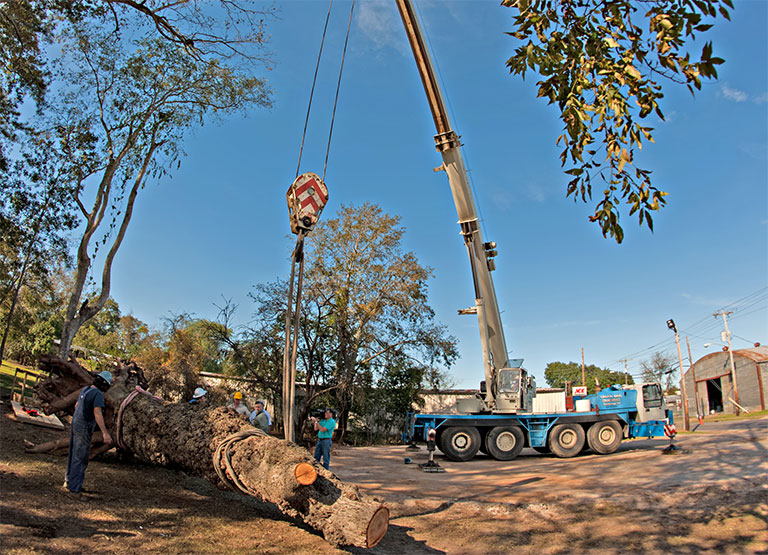
The Blakely Burl Tree comes to rest on the ground.
Photo: John McFadden
Once they have made their decisions
about where to cut, Gary trims the smaller roots away. The crew take it in turns
to gouge away at the dirt with crowbars and pickaxes, gradually clearing the
dirt. It’s a slow, hand-blistering process as Mark insists that damage to the
roots is minimized. “There’s going to be some interesting possibilities with
these shapes,” he says.

Gary Stevens (right) and team cleaning dirt from roots.
Photo: John McFadden
The work of removing the dirt will take hours, so Ken, Greg and I visit the high
school to see some of the woodshop students at work and talk to them about their
impressions of the Burl Tree Project. When we arrive I am happy to see that the
students are busy turning wooden pens on lathes. We interview some of them for
the camera and ask them what they hope they will do in the future. I am
impressed by their polite responses and by the clarity of their plans. One young
man, appropriately named Turner, tells me that he’d like to pursue a career in
woodwork. Maybe the Burl Tree Project is already planting mental seeds, so I ask
them for their thoughts on the project. One young woman shyly asks, “Is it true
that tree is worth over a million dollars?”
They deserve an answer to that question, so I explain to them that burl trees
are found all over the world, but that the Blakely Burl Tree is unusual because
it is a pecan tree and none of us has ever heard of pecan burl tree before.
“But,” I explain, “just because it’s rare doesn’t mean that it’s really
valuable. Some burls are valuable and a whole burl tree can be extremely
valuable, but because we’ve never seen pecan burl, we don’t know yet what it’s
worth.”
The looks of disbelief on their faces are a clear answer. “So,” I explain
further, “I suppose you want to know why we’re working so hard to get that
tree?” Heads nod, so I explain the history of the site and the plans for making
art works to be shown in a museum there. “It’s not so much the tree that’s
valuable,” I say, “it’s what can be made from the tree that is going to be
valuable. And you know,” I add, “there is a value that can’t be measured.”
“What’s that,” one young man asks. “It’s what it symbolizes,” I say. “What it
can mean to the town.” I see them exchange glances, so I can only hope that as
the project evolves and the art work starts to return to the town, they will
understand.
When we return to the site, Mark has called a halt. Most of the dirt has been
removed from the root ball.
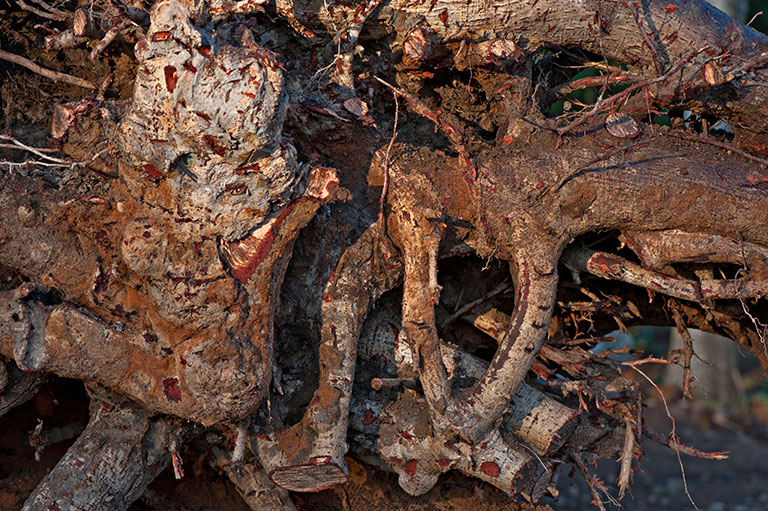
Most of dirt cleaned from roots. Photo:
John McFadden
Also, the hole in the ground has been filled and
there is no evidence that a tree was ever there. Tomorrow will be our last day
on this site and it will also be when we first cut into the trunk to see what is
inside. Mark ends the day, as always, by thanking everyone for their hard work.
“Tomorrow will be great,” he says. “We finally get to see what we’ve got.” He
smiles broadly, but later I see him sitting quietly with a far-away look on his
face. Mark has a lot riding on what happens tomorrow.
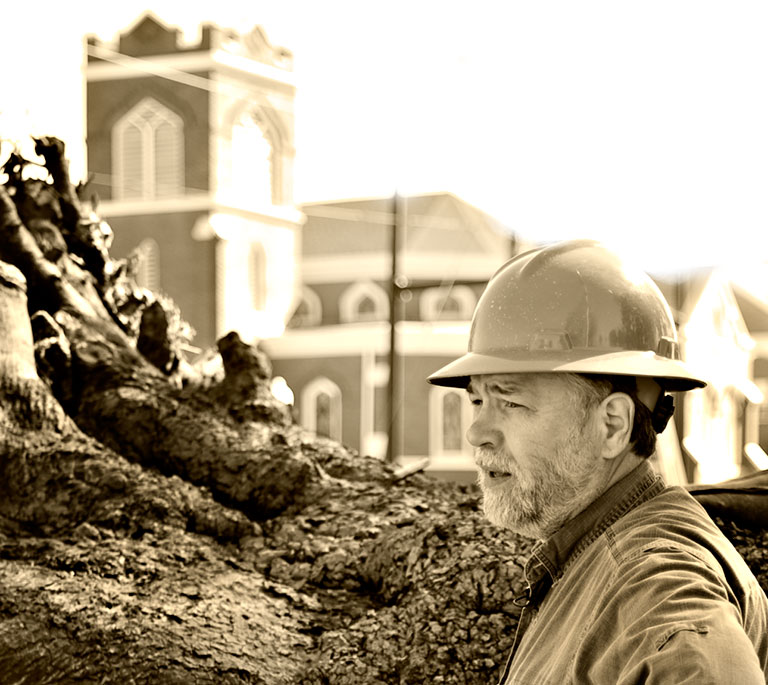
Mark Lindquist at Blakely Burl Tree Site, end of day.
Photo: John McFadden